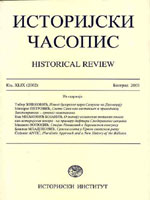Генеалогије између историје и идеологије: пример порекла кнегиње Милице
Genealogies between History and Ideology: The Example of the Origin of Princess Milica
Author(s): Marija VasiljevićSubject(s): History, Middle Ages
Published by: Istorijski institut, Beograd
Keywords: Middle Ages; genealogies; Vukan-Milica lineage; grid of perception
Summary/Abstract: Medieval genealogies were written with the intention to present а specific family’s or person’s origin. They illustrate the need to legitimize their hold on power or the aim to acquire it, and to demonstrate that the achieved or desired authority is legal. This paper explores the use of genealogies in the political life of late medieval Serbian lands. The case in question is that of the wife of prince Lazar, Milica, who is presented as a descendant of prince Vukan, the eldest son of the Serbian ruler-saint, Stefan Nemanja. The analysis is conducted by comparing all of the sources that refer to Milica’s ancestry. There search shows that the available information can be divided into two groups: one where unspecified kinship with the Nemanjić dynasty is mentioned and the other where the Vukan-Milica lineage is clearly stated. Various sources, ranging from stemma-chronicles, liturgical texts and one charter issued by Milica’s son, despot Stefan Lazarević, belong to the first group. Moreover, all of them were written during the life of the princess, or very shortly after her death. The first genealogy that notes the Vukan-Milica lineage is found in the Life of despot Stefan Lazarević, written by Constantine of Kostenets at the time of despot Stefan’s nephew and successor Đurađ Branković. This political and unconventional hagiography is marked by rewriting and reinterpretation of certain parts of the despot’s life. With this questionable approach to the past, the author presents a genealogy of despot Stefan. Emperor Constantine the Great becomes an ancestor of the Nemanjić dynasty and, through the Vukan-Milica lineage, of the despot himself. This falsified genealogy belongs to the type of lay genealogies, characterized by ideological attitudes and loose attachment to the historical truth. Even though the main branch of the Nemanjićs is presented correctly, it is not possible to accept the lineage in question without confirmation from other sources. Yet, the other sources do not repeat it. Afterward, the lineage is often distorted and the aim to unite all the prominent figures of medieval times in a single family tree is quite noticeable. Consequently, genealogies become filled with further fabrications. Later on, they are interpolated in other historiographical genres, one stemma-chronicle from the 16th and chronicles from the 16th and 17th century. In the end, although the Vukan-Milica lineage cannot be accepted from the methodological point of view, with the current state of the sources it is not possible to offer an alternative version of family relations between the princess and the Nemanjić dynasty. It could be argued that the success of the one we find in the Life of despot Stefan lies in the absence of living protagonists of the genealogy, an appropriate number of inserted personalities and the convenience of its narrative for despot Đurađ Branković and his successors.
Journal: Историјски часопис
- Issue Year: 2016
- Issue No: 65
- Page Range: 79-99
- Page Count: 21
- Language: Serbian

